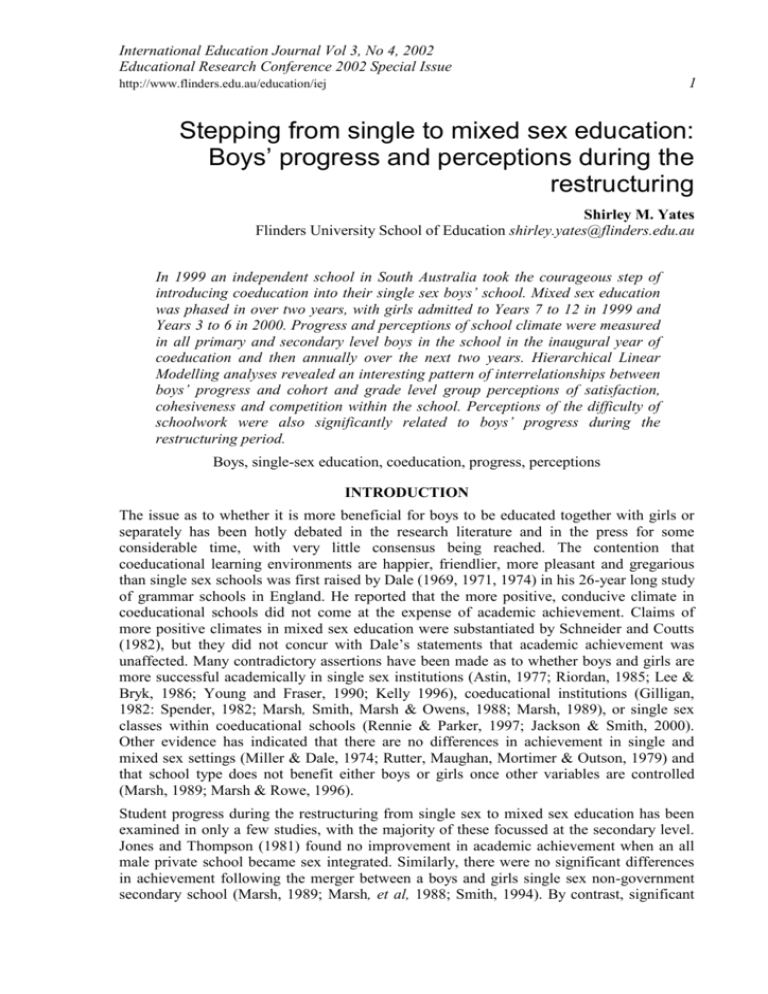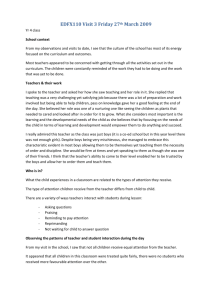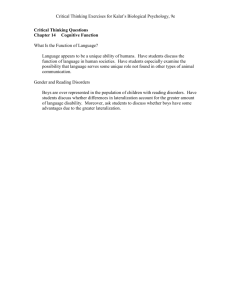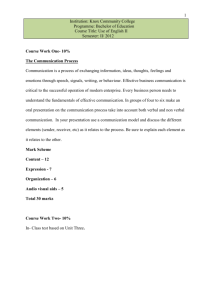
International Education Journal Vol 3, No 4, 2002
Educational Research Conference 2002 Special Issue
1
http://www.flinders.edu.au/education/iej
Stepping from single to mixed sex education:
Boys’ progress and perceptions during the
restructuring
Shirley M. Yates
Flinders University School of Education shirley.yates@flinders.edu.au
In 1999 an independent school in South Australia took the courageous step of
introducing coeducation into their single sex boys’ school. Mixed sex education
was phased in over two years, with girls admitted to Years 7 to 12 in 1999 and
Years 3 to 6 in 2000. Progress and perceptions of school climate were measured
in all primary and secondary level boys in the school in the inaugural year of
coeducation and then annually over the next two years. Hierarchical Linear
Modelling analyses revealed an interesting pattern of interrelationships between
boys’ progress and cohort and grade level group perceptions of satisfaction,
cohesiveness and competition within the school. Perceptions of the difficulty of
schoolwork were also significantly related to boys’ progress during the
restructuring period.
Boys, single-sex education, coeducation, progress, perceptions
INTRODUCTION
The issue as to whether it is more beneficial for boys to be educated together with girls or
separately has been hotly debated in the research literature and in the press for some
considerable time, with very little consensus being reached. The contention that
coeducational learning environments are happier, friendlier, more pleasant and gregarious
than single sex schools was first raised by Dale (1969, 1971, 1974) in his 26-year long study
of grammar schools in England. He reported that the more positive, conducive climate in
coeducational schools did not come at the expense of academic achievement. Claims of
more positive climates in mixed sex education were substantiated by Schneider and Coutts
(1982), but they did not concur with Dale’s statements that academic achievement was
unaffected. Many contradictory assertions have been made as to whether boys and girls are
more successful academically in single sex institutions (Astin, 1977; Riordan, 1985; Lee &
Bryk, 1986; Young and Fraser, 1990; Kelly 1996), coeducational institutions (Gilligan,
1982: Spender, 1982; Marsh, Smith, Marsh & Owens, 1988; Marsh, 1989), or single sex
classes within coeducational schools (Rennie & Parker, 1997; Jackson & Smith, 2000).
Other evidence has indicated that there are no differences in achievement in single and
mixed sex settings (Miller & Dale, 1974; Rutter, Maughan, Mortimer & Outson, 1979) and
that school type does not benefit either boys or girls once other variables are controlled
(Marsh, 1989; Marsh & Rowe, 1996).
Student progress during the restructuring from single sex to mixed sex education has been
examined in only a few studies, with the majority of these focussed at the secondary level.
Jones and Thompson (1981) found no improvement in academic achievement when an all
male private school became sex integrated. Similarly, there were no significant differences
in achievement following the merger between a boys and girls single sex non-government
secondary school (Marsh, 1989; Marsh, et al, 1988; Smith, 1994). By contrast, significant
2
Stepping from single to mixed sex education: Boys' progress and perceptions
increases in general educational progress were evident in primary and secondary boys from
Grades 3 to 12 following the introduction of co-education into two non-government single
sex boys schools (Yates, 2000; 2001a; 2001b; 2002a). Contradictory evidence has also been
reported in relation to classroom conduct following the introduction of coeducation (Mael,
1998), with Jones and Thompson (1981) citing improvements and Payne and Newton (1990)
mixed views about the behaviour of boys. In a separate study of a merger of a single sex
secondary girls school with a boys school, girls reported feeling intimidated, hesitant,
uncomfortable and dumb during mathematics lessons in mixed sex classrooms, but the
views of the boys were not canvassed (Steinbeck & Gwizdala, 1995). Boys’ educational
progress in newly amalgamated mixed education classrooms has not been investigated in
relation to perceptions of the school learning environment.
School climate has long been recognised as one of the variables having an important effect
on student learning (Rutter, Maughan, Mortimer & Outson, 1979; Anderson, 1992; Fraser,
1994; Bulach & Malone, 1994: Bulach, Malone & Castleman, 1995). A large body of
evidence attests to strong associations between cognitive and affective outcomes for
students and their perceptions of the psychosocial characteristics of their classrooms
(Haertel, Walberg & Haertel, 1981; Fraser, Welch, Hattie & Walberg, 1987; Fraser, 1998).
A meta-analysis of studies involving 17,805 students in 823 classes in eight subject areas
across four nations found student achievement was enhanced in classrooms with greater
Cohesiveness, Goal Direction and Satisfaction and less Disorganisation and Friction
(Haertel, Walberg & Haertel, 1981). Cohesiveness, Friction and Satisfaction were originally
identified as significant aspects of Relationship dimensions and Goal Direction and
Disorganisation as part of the System Maintenance and Change dimensions postulated by
Moos (1974). In the same classification schema of human environments Moos included a
third dimension of Personal Development encompassing Competitiveness and Difficulty.
The Relationship, Personal Development and System Maintenance and Change dimensions
have been studied in many different learning environments, predominantly at the secondary
school level (Fraser, 1998), but have not been measured in schools during the introduction
of mixed sex education into a single sex school.
The present study was conducted in a non-government fee-paying school during the period
of restructuring from single to mixed sex education. Co-education was phased into the
school over a two-year period, with 43 girls entering Grades 7 to 12 in Term 1, 1999 and 23
girls in the primary Grades 3 to 6 in Term 1, 2000. In total, across Grades 3 to 12 there were
92 girls in 2000 and 123 girls in 2001. Perceptions of the school learning environment and
educational progress were measured annually in Term 4 in primary and secondary school
boys during the two-year transitional period and in the following year. The study began with
boys present at the time of the initial introduction of co-education, and followed them as
they experienced the changes brought about by the radical alteration to the gender mix in the
school population. Their perceptions, measured by questionnaires, tapped their impressions
and experiences over several lessons, activities and events and when pooled across them,
provided a rich source of direct information about life within the coeducational school.
AIMS
The aims of this study were to:
1. measure, monitor and evaluate boys’ perceptions of school climate and educational
progress during the restructuring from single to mixed sex education;
2. examine cohort and grade level differences in boys’ perceptions of school climate and
educational progress over time;
Yates
3
METHOD
Participants
All boys in Grades 3 to 11 attending the school in 1999, when coeducation was introduced
into Grades 7 to 12, participated. Table 1 presents the numbers of boys in Grades 3 to 11 at
Time 1 (T1) (1999), Grades 4 to 12 at Time 2 (T2) (2000) and Grades 5 to 12 at Time 3 (T3)
(2002).
Table1. Number of boys by Grade level at Time 1, Time 2 and Time 3
T1
Gr 3
Gr 4
Gr 5
Gr 6
Gr 7
Gr 8
Gr 9
G 10
G11
25
31
34
40
40
49
71
75
76
23
27
33
40
40
48
71
76
76
433
22
23
27
29
32
43
48
57
363
83
98
107
118
151
189
199
133
1237
T2
T3
Total
25
54
G 12
Total
441
There is some variability in the numbers of boys over the three-year period, with higher
levels of attrition evident in some grades than in others. Student ID numbers used for data
entry in SPSS (Norusis, 1993) were generated from school class lists at T1. Some boys were
absent at T1, T2 or T3 or had left the school altogether at T2 or T3. There were, however,
sufficient numbers of boys at each grade level on each occasion for the statistical analyses to
be conducted.
Instruments
School Climate Questionnaires:
Boys’ perceptions of the psychosocial climate of the school were measured with My School
Inventory, adapted from My Class Inventory (see, Fisher & Fraser, 1981; Fraser, Anderson
& Walberg, 1982) or the School Learning Environment Inventory a modification of the
Learning Environment Inventory (Anderson & Walberg, 1974; Fraser, Anderson &
Walberg, 1982). In each inventory boys were presented with a series of statements and were
asked to indicate whether or not they agreed with them. My School Inventory was composed
of 38 items measuring five aspects of school climate while the School Learning
Environment contained 108 items measuring 15 aspects. Five aspects, defined as separate
subscales, measuring boys’ perceptions of the Relationship and Personal Development
dimensions (Moos, 1974) of the school were common to both inventories. The Relationships
dimensions, measured through three subscales of Cohesiveness, Friction and Satisfaction in
each inventory, tapped the nature and intensity of students’ personal relationships, conflict,
arguments and disagreements between students and their contentment and happiness with
the school learning environment respectively. The Personal Development dimensions
measured by two subscales of Competitiveness and Difficulty assessed the extent to which
students competed with each other and their perceptions of the difficulty of their
schoolwork. Sample items from the Relationship and Personal Development dimensions
within My School Inventory (MSI) and School Learning Environment Inventory (SLEI) are
presented in Table 2.
Educational Progress:
Students’ educational progress was measured over three consecutive years with the Word
Knowledge Test 1, 2 or 3 (Thorndike, 1973). These tests have been used previously in
international studies as a general assessment of students’ achievement and underlying
scholastic aptitude. They were chosen as they could be administered, compiled into a single
4
Stepping from single to mixed sex education: Boys' progress and perceptions
scale with the common items linking procedure and compared across Grades 3 to 12. Each
test consists of 40 word pairs, rated as the same or opposite in meaning. Thirteen word pairs
are common to Tests 1 and 2 and 20 items are common to Tests 2 and 3. One word pair is
common to all three tests. Table 3 presents sample items from Test 1, Test 2 and Test 3.
Table 2. Sample items for the Relationship and Personal Development dimensions
within My School Inventory (MSI) and School Learning Environment Inventory (SLEI)
Relationship Dimensions:
Cohesiveness
MSI
Item 28
Children in our school like each other as friends
SLEI
Item 31
Students in the school are frequently personal friends
MSI
Item 2
Children are always fighting with each other
SLEI
Item 6
There is constant bickering among students
MSI
Item 16
Most children say the school is fun
SLEI
Item 73
Students look forward to coming to classes
Friction
Satisfaction
Personal Development Dimensions:
Competitiveness
MSI
Item 24
Some students try to do their work better than the others
SLEI
Item 30
Students compete to see who can do the best work
MSI
Item 3
In our school work is hard to do
SLEI
Item 54
Students tend to find the schoolwork hard to do.
Difficulty
Table 3. Sample items from Word Knowledge Test 1, Test 2 and Test 3
Item
Word Knowledge Test 1
Word Knowledge Test 2
Word Knowledge Test 3
1
quick
slow
savoury
insipid
acquire
dispel
40
scarce
rare
obvious
indisputable
ephemeral
eternal
Procedure
The school climate questionnaire and word knowledge test were administered to all boys in
their classrooms at the same time and day in October at T1, T2 and T3. Word Knowledge
Test 1 was administered to boys in Grades 3 to 7, Word Knowledge Test 2 to Grades 8 to 10
and Word Knowledge Test 3 to Grades 11 and 12. Primary school boys in Grades 3 to 7 were
administered My School Inventory, with the School Learning Environment Inventory given
to the secondary level boys in Grades 8 to 12. My School Inventory was also completed by
Grade 8 and Grade 9 boys to provide a common group for equating purposes.
Analyses
Boys’ responses at T1, T2 and T3 were entered into an SPSS file (Norusis, 1993), with data
matched across each occasion through their student ID number. The two school climate
questionnaires and three word knowledge tests were calibrated with the Rasch scaling
procedure (Rasch, 1966) using QUEST (Adams & Khoo, 1994) and all non-fitting items
deleted. Five separate school climate subscales of Cohesiveness (COH), Competitiveness
(COM), Difficulty (DIF), Friction (FRI) and Satisfaction (SAT) were then formed from the
designated items in the My School Inventory and School Learning Environment Inventory.
Yates
5
Each of the subscales from the two inventories were linked by the responses of the Grade 8
and 9 boys who had completed both questionnaires. The combined COH subscale contained
13 items, the COM subscale 12 items, the DIF subscale 14 items, the FRI subscale 15 items
and SAT subscale 14 items.
A single Word Knowledge (WK) scale of student progress was formed from Word
Knowledge Tests 1, 2 and 3, with the tests linked by the 13 items common to Tests 1 and 2,
the 20 items common to Test 2 and 3 and the one item common to all three tests. The
scoring of WK was then anchored to only those students who answered all items. Case
estimate scores for all boys for T1, T2 and T3 were equated concurrently for the COH,
COM, DIF, FRI and SAT scales and the WK scale.
Relationships between the five school climate subscales and the WK scale measured over
the three years of the study were analysed with Hierarchical Linear Modelling (HLM)
(Raudenbush, Bryk, & Congdon, 2000), using HLM5. This procedure is eminently suited to
longitudinal designs (Von Eye, 2001). Within group comparisons were made over time at
level-1, and between cohort groups and grades at level-2. Cohort groups consist of the same
boys clustered by their initial grade at T1, while Grade groupings are composed of boys in
that grade level at T1, T2 and T3 respectively.
RESULTS
Students in any school or classroom are more similar to each other than they are to students
randomly sampled from a school region, sector or national population (Osborne, 2000).
Furthermore, as this study was conducted in a single fee paying, non-government school, it
is likely that students share certain background, environmental and experiential
characteristics (Osborne, 2000). Hierarchical Linear Modelling was therefore employed as it
permits the examination of the direct effect of various potential predictors at level-1 and
level-2 as well as modelling of cross-level interaction effects. Two models were developed,
with boys grouped at level-2 by cohort in Model 1, presented in Figure 1 and by grade level
at T1, T2 and T3 in Model 2, presented in Figure 2. Boys’ progress, measured by WK, was
designated as the outcome variable in both models. Coefficients and standard errors for each
significant variable, which is enclosed within an ellipse, are presented at both the student
and group level within each model. Taken together, all of the five school climate subscales
are significantly related to boys’ progress at either level 1 or level 2 or both, but the manner
in which they do so varies between the two models.
Model 1:Boys grouped by cohort
Figure 1 and Table 4 present the significant effects for Model 1.
At level 1 boys’ perceptions of the difficulty of their school work (DIF) and Time are
significantly related to WK. On average, all cohort groups show significant increases in WK
scores over time. At level 2 there is a direct, significant, negative relationship between
Cohort 9 and WK, indicating that this cohort group had significantly lower WK scores than
the other cohort groups. There are also direct, significant, negative relationships between
Satisfaction (SAT) and WK and between Competitiveness (COM) and WK. Cohort groups
that on average had higher levels of SAT recorded lower WK levels, as did cohort groups
with higher levels of COM. Conversely, cohorts which expressed lower levels of SAT
experienced higher gains in WK. although the significant positive interaction effect between
SAT and Time in Model 1 indicates that satisfaction increased across the school over the
three years of the study. There is a significant positive interaction effect between SAT at
level 2 and COH at level 1 indicating that boys reporting high levels of cohesiveness in
cohorts that are, on average, more satisfied with school life have lower WK scores. By
6
Stepping from single to mixed sex education: Boys' progress and perceptions
contrast, less cohesive boys in cohort groups that express lower levels of satisfaction
experience higher WK gains. However, cohesiveness alone is not a significant variable
except for boys in Cohort 7 where it is negatively related to WK. Perceptions of difficulty of
schoolwork (DIF) is a significant variable at both levels 1 and 2. The interaction effect
between DIF at level 2 and level 1 indicates that the cohort group’s perceptions of difficulty
influence individual perceptions, such that on average, boys in cohort groups who do not
perceive school work to be difficult are more likely to have higher WK scores. On the other
hand, in cohort groups that perceive the work to be difficult there is almost no difference in
the word knowledge scores of individual boys irrespective of their own perceptions of
difficulty.
Figure 1. Model 1: Boys grouped by cohort
Table 4. Model 1: Boys grouped by cohort
Final estimation of fixed effects:
Fixed Effect
Coefficient
For INTRCPT1, B0
INTRCPT2, G00
1.18
ENRSSS_1G01
-0.41
ENRSSC_1G02
-0.83
C9_1, G03
-0.44
For TIME slope, B1
INTRCPT2, G10
0.19
ENRSSS_1,G11
0.15
For ENRSSDIF slope, B2
INTRCPT2, G20
-0.06
ENRSSD_1, G21
0.07
C7_1, G22
-0.16
For ENRSSCOH slope, B3
INTRCPT2, G30
0.00
ENRSSS_1,G31
-0.05
C7_, G32
-0.16
Final estimation of variance components:
Standard
Random Effect
Deviation
INTRCPT1, U0
0.07
TIME slope, U1
0.15
ENRSSDIF slope, U2
0.01
ENRSSCOH slope, U3
0.04
level-1, R
0.86
Std Error
T-ratio
d.f.
P-value
0.04
0.04
0.17
0.11
30.28
-10.63
-4.84
-4.02
5
5
5
5
0.000
0.000
0.003
0.014
0.06
0.06
3.10
2.68
7
7
0.019
0.032
0.02
0.03
0.06
-2.59
2.30
-2.60
6
6
6
0.041
0.061
0.041
0.02
0.02
0.07
-0.09
-2.42
-2.26
6
6
6
0.931
0.051
0.064
df
Chi-square
P-value
5
7
6
6
7.66
19.10
2.29
9.70
0.175
0.008
>0.500
0.137
Variance
Component
0.00
0.02
0.00
0.00
0.75
Yates
7
Model 2:Boys grouped by Grade level
Figure 2 and Table 5 present the significant effects for Model 2.
Figure 2. Model 2: Boys grouped by grade
Table 5.Model 2: Boys grouped by grade
Final estimation of fixed effects
Fixed Effect
Coefficient
For INTRCPT1, B0
INTRCPT2, G00
0.93
ENRSSS_1G01
-0.29
ENRSSC_1G02
-0.88
Y7_1, G03
0.56
Y12_1. G04
0.52
For TIME slope, B1
INTRCPT2, G10
0.01
ENRSSD_1, G11
-0.17
Y11_1, G12
0.29
For ENRSSSAT slope, B2
INTRCPT2, G20
0.03
Y10_1, G21
-0.12
For ENRSSFRI slope, B3
INTRCPT2, G30
0.000
Y7_1, G31
0.16
For ENRSSDIF slope, B4
INTRCPT2, G40
-0.08
For ENRSSCOH slope, B5
INTRCPT2, G50
-0.04
ENRSSS_1, G51
-0.06
Final estimation of variance components:
Standard
Random Effect
Deviation
INTRCPT1, U0
0.12
TIME slope, U1
0.07
ENRSSSAT slope, U2
0.02
ENRSSFRI slope, U3
0.03
ENRSSDIF slope, U4
0.07
ENRSSCOH slope, U5
0.01
level-1, R
0.86
Std. Error
T-ratio
d.f.
P-value
0.06
0.05
0.28
0.14
0.12
16.22
-6.27
-3.11
4.15
4.13
5
5
5
5
5
0.000
0.000
0.030
0.012
0.012
0.05
0.07
0.11
0.13
-2.38
2.54
7
7
7
0.898
0.049
0.039
0.02
0.05
1.25
-2.19
8
8
0.247
0.059
0.02
0.06
0.22
2.70
8
8
0.834
0.027
0.03
-2.63
9
0.028
0.02
0.02
-2.02
-3.67
8
8
0.078
0.007
d.f
Chi-square
P-value
4
6
7
7
8
7
19.72
7.22
2.77
6.72
16.45
2.25
0.001
0.300
>.500
>.500
0.036
>.500
Variance
Component
0.02
0.01
0.00
0.00
0.00
0.00
0.74
8
Stepping from single to mixed sex education: Boys' progress and perceptions
All five of the school climate variables are evident at either level 1 or level 2 in Model 2. In
these analyses in which boys were grouped by grade, WK scores for all grade levels were
not significantly different from the overall mean, except for Grades 7 and 12 which were
significantly higher. With the exception of Grade 11, there were no significant increases in
WK scores over time. Average WK scores for each grade were influenced by average levels
of SAT and COM, so that grades with higher scores in SAT and COM respectively tended to
have lower WK scores. An interaction was also evident between SAT and COH. Boys in
grades which, on average, recorded higher levels of SAT and COH had lower WK scores.
By contrast, those in Grades which on average had lower levels of SAT and COH gained
higher WK scores. At the individual student level, satisfaction with school life was not a
significant factor except for students in Grade 10 where higher levels of SAT were related to
less progress. Boys’ perceptions of friction within the school was similarly not a significant
factor in the grade analyses except in Grade 7 where FRI had a positive effect on WK.
However, there was a significant interaction between DIF and Time, such that grade levels
which on average perceived the perceived schoolwork to be less difficult had increasing WK
scores over time. Conversely, grade levels where on average schoolwork was perceived to
be more difficult evidenced less progress over time. As boys’ WK scores decreased, they
perceived their schoolwork to be more difficult.
Summary of the results
1. All cohort groups made significant progress as measured by WK. Grades 7 and 12 had
significantly higher WK scores when compared to the overall mean, but only Grade 11
recorded significant increases over time.
2. Boys’ WK scores were influenced by their perceptions of the school climate at both the
individual and group level.
3. Satisfaction and competitiveness were significant variables in both the cohort and grade
analyses.
4. Satisfaction also interacted with cohesiveness to influence WK outcomes.
5. Perceptions of the difficulty of schoolwork had a significant influence on boys’ progress,
particularly for cohort 7 and over time in the grade analyses.
6. Friction was not a significant variable except for Grade 7.
DISCUSSION
In a comprehensive review of the relationships between socioemotional and academic
development in single and mixed sex education, Mael (1998) foreshadowed the need for
future research to take both the individual student and organisational contexts of an
educational setting factors into account. While the present study was conducted only on a
single school during a period of significant structural change, it was designed so that
individual and group factors could be considered together with aspects of the learning
environment. The use of Hierarchical Linear Modelling enabled predictive relationships
between boys’ perceptions of the school climate and their educational progress to be
explored at both individual and group levels, as well as any potential cross level interactions
between them. Furthermore, while previous studies have been focussed predominantly on
students at the secondary level, both primary and secondary boys participated in this study.
With the use of the Rasch scaling procedure, single scales were formed which enabled boys’
perceptions and progress to be viewed from Grades 3 to 12 across the school as well as over
time. Finally, this study is unique precisely because it measured boys’ progress and captured
Yates
9
their perceptions of the climate of their school during the period of the restructuring from a
unisex to a coeducational school.
The finding that educational progress, as measured by the Word Knowledge test, increased
significantly for all cohorts indicates that over time, the gradual introduction of girls into a
single sex boys school was not disadvantageous for boys present in the school when
coeducation was introduced. However, this progress was clearly influenced by boys’
perceptions of climatic variables - most notable, satisfaction, cohesion, competitiveness and
difficulty. The relationships between satisfaction and progress in Models 1 and 2 affirm and
extend the findings from the meta-analytic review of Haertel, Walberg & Haertel (1981).
The fact that the relationship between the two variables in both models is negative can be
interpreted in light of previous analyses of the longitudinal data from this study which has
shown boys’ satisfaction with school life to decrease across Grade levels and word
knowledge scores to increase (Yates, 2001b, 2002b). In general, boys in the higher grade
levels are less satisfied with school than boys in the lower grades, although the cohort
analyses in Model 1 show satisfaction to have increased significantly over time. However,
there are also interesting interaction effects between boys’ progress and Moos’ (1974)
Relationship dimensions of satisfaction and cohesion in both models. By itself cohesion was
not a significant variable except for boys in Cohort 7. Likewise, with the exception of Grade
7, the Relationship dimension of friction was not a significant variable. These results are
somewhat surprising, as the meta-analysis of classroom climate research highlighted the
important roles played by Cohesiveness, Friction and Satisfaction in student achievement
outcomes (Haertel, Walberg & Haertel, 1981). While this study was confined to boys only,
these results would suggest that the manner in which Moos (1974) Relationship dimensions
operate may need to be reconsidered, particularly when group effects are taken into account
with newer statistical techniques such as Hierarchical Linear Modelling (Mael, 1998).
In both models there are significant, negative relationships between boys’ perceptions of
competitiveness in relation to their schoolwork at both cohort and grade levels and their
educational progress at level 1. Similarly, there are signification interactions between boys’
perceptions of the difficulty of schoolwork and progress over time. Both of these variables
belong to Moos’ (1974) dimension of Personal Development. These findings need to be
investigated further to determine whether they are gender specific, or whether they pertain
only to the present sample of boys who were attending the school at the time that
coeducation was first introduced. Explication of this result may have implications for the
widely held view, consistent across several studies, that boys are generally advantaged in
coeducational settings (see, Mael, 1998).
Overall, the results from this study found boys’ educational progress and perceptions of their
school climate during the transition from single sex to coeducation to be interrelated in a
manner not previously demonstrated in earlier research. The HLM analyses showed that
these relationships operated at both the individual and group levels, with some differential
effects for cohort and grade level groupings. These findings contribute to the debate about
single sex and coeducation, particularly in relation to the transition from one system to
another, as they indicate boys’ progress is influenced significantly by some school climate
variables. They also establish the importance of examining factors at both the individual
student and group levels. Further studies are now needed to confirm whether these
interrelationships are sustainable over time, particularly when the initial impact of the
restructuring from single to mixed sex education has attenuated in the school. The study
could also be extended to include other variables, the girls who have entered the school, as
well as the perceptions of the teachers.
10
Stepping from single to mixed sex education: Boys' progress and perceptions
Acknowledgments
1.
2.
3.
4.
Professor John P. Keeves for his unfailing interest, support and expertise.
I Gusti Ngurah Darmawan for invaluable assistance with data analyses.
Research assistants John Harris & Dianne Harris.
The research was supported by Australian Research Council and Flinders Small Grants.
REFERENCES
Adams, R.J. & Khoo, S.K. (1994). Quest- The interactive test analysis system. Hawthorn, Victoria: ACER.
Anderson, C. S. (1992). The search for school climate: A review of research. Review of Educational Research,
32, 368-420.
Anderson, G. J. & Walberg, H. J. (1974). Learning environments. In H. J. Walberg (Ed.), Evaluating
educational performance: A sourcebook of methods, instruments, and examples. Berkeley: McCutchan.
Astin, A .W. (1977). On the failure of educational policy. Change, 9, 40-45.
Bulach, C. R. & Malone, B. (1994). The relationship of school climate to the implementation of school reform.
ERS Spectrum, 12 (4), 3-8.
Bulach, C. R., Malone, B. & Castleman, C. (1995). An investigation of variables related to student
achievement. Mid-Western Educational Researcher 8 (2), 23-29.
Dale, R. R. (1969). Mixed or single sex schools?: Vol 1 A research study about pupil-teacher relationships.
London: Routledge& Kegan Paul.
Dale, R. R. (1971) Mixed or single sex schools? Vol 2 Some social aspects. London: Routledge & Kegan Paul.
Dale, R. R. (1974) Mixed or single sex schools? Vol 3 Attainments, attitudes and overview.
Routledge & Kegan Paul.
London:
Fisher, D. L. & Fraser, B. J. (1981). Validity and use of My Class Inventory. Science Education, 65, 145-156.
Fraser, B. J. (1994). Research on classroom and school climate. In D, Gabel (Ed.), Handbook of research on
science teaching and learning. (pp. 493-541) New York: Macmillan.
Fraser, B. J. (1998). Science learning environments: Assessment, effects and determinants. In B. J. Fraser & K.
G. Tobin (Eds.), The international handbook of science education (pp. 527-564). Dordrecht, The
Netherlands: Kluwer.
Fraser, B. J., Anderson, G. J. & Walberg, H. J. (1982). Assessment of learning environments: Manual for
Learning Environment Inventory (LEI) and MY Class Inventory (MCI) (third version) Perth: Western
Australian Institute of Technology.
Fraser, B. J., Welch, W. W., Hattie, J. A. & Walberg, H. J. (1987). Syntheses of educational productivity
research. International Journal of Educational Research, 11, 147-252.
Gilligan, C. (1982). In a different voice: Psychological theory and women’s development. Cambridge, MA:
Havard University Press.
Haertel, G. D., Walberg, H. J. & Heartel, E. H. (1981). Socio-psychological environments and learning: A
quantitative synthesis. British Educational Research Journal, 7, 27 -36.
Jackson, C. & Smith, I. D. (2000). Poles apart? An exploration of single-sex and mixed sex educational
environments in Australia and England. Educational Studies, 26 (4), 409-422.
Jones, M. B. & Thompson, D. G. (1981). Classroom misconduct and integration by sex. Journal of Child
Psychology and Psychiatry. 22, 401-409.
Kelly, A. (1996). Comparing like with like Education, 187, 14-15.
Lee, V. E. & Bryk, A. S. (1986). Effects of single-sex secondary schools on student achievement and attitudes,
Journal of Educational Psychology, 78, 381-395.
Mael, F. A. (1998). Single-sex and coeducational schooling: Relationships to socioemotional and academic
development. Review of Educational Research, 68 (2), 101-129
Marsh, H. W. (1989). Effects of attending single-sex and coeducational high schools on achievement, attitudes,
behaviours and sex differences., Journal of Educational Psychology, 81, 70-85.
Marsh, H. W. & Rowe, K. (1996). The effects of single-sex and mixed-sex mathematics classes within a
coeducational school: A re-analysis. Australian Journal of Education, 40, 147-162.
Yates
11
Marsh, H. W., Smith I. D., Marsh, M., & Owens, L. (1988). The transition from single-sex to coeducational
high schools: Effects on multiple dimensions of self-concept and on academic achievement. American
Educational Research Journal, 25, 237-269.
Miller, P, McC. & Dale, R. R. (1974). A comparison of the degree results of university students from
coeducational and single-sex schools. British Journal of Educational Psychology, 44, 307-308.
Moos, R. H. (1974). The social climate scales: An overview. Palo Alto, California: Consulting Psychologists
Press.
Norusis, M. J. / SPSS Inc. (1993). SPSS for windows base system user's guide release 6.0.
Osborne, J. W. (2000). Advantages of hierarchical linear modelling. Practical Assessment, Research &
Evaluation, 7 (1), [Available on-line: http://ericae.net/pare/getvn.asp?v=7&n=1]
Payne, M. A. & Newton, E. H. (1990). Teachers and students perceptions of major advantages and
disadvantages of coeducational secondary schooling. Australian Journal of Education, 34, 67-86.
Rasch, G. (1966). An item analysis which takes individual differences into account. British Journal of
Mathematical and Statistical Psychology, 19, 49-57.
Raudenbush, S., Bryk, A. & Congdon, R. (2000). HLM5 Hierarchical linear and nonlinear modelling.
Scientific Software International.
Rennie, L. J. & Parker, L. H. (1997). Perceptions of single- sex and mixed-sex mathematics classes.
Mathematics Education Research Journal. 9, (3), 257-273.
Riordan, C. (1985). Public and catholic schooling: The effects of gender context policy. American Journal of
Education, 5, 518-540.
Rutter, M., Maughan, B., Mortimore, P. & Ouston, J. (1979). Fifteen thousand hours: Secondary schools and
their effects on children, London: Open Books.
Schneider, F. W. and Coutts, L. M. (1982). The high school environment: A comparison of coeducational and
single sex schools. Journal of Educational Psychology, 74, 898-906.
Smith, I. D. (1994). The coeducational/ single sex schooling debate. Forum of Education, 51, 15-31.
Spender, D. (1982). Invisible women: The schooling scandal. London: Writers and Readers Press.
Steinbeck, M. and Gwizdala, J. (1995) Gender differences in mathematics attitudes of secondary school
students. School Science and Mathematics. 95 (1), 36-42.
Thorndike, R. L. (1973). Reading comprehension in fifteen countries. New York, Wiley: and Stockholm:
Almqvist & Wiksell.
Von Eye, M. (2001). Structural Equation Modelling. Workshop presented at the 9th European Association for
Research in Learning and Instruction, Fribourg, Switzerland, 27 August. Journal of Education, 43 (2),
142-156
Yates, S. M. (2000). Student optimism and pessimism during the transition to co-education. Presented at the
annual conference of the Australian Association for Research in Education, Sydney, December,
www.aare.edu.au/00pap/yat00439.htm.
Yates, S. M. (2001a) Students’ educational achievement and perceptions during the transition from single sex
to co-education. Paper presented at the 9th European Association for Research in Learning and Instruction,
Fribourg, Switzerland, 29 August.
Yates, S. M. (2001b). Students’ achievement and perceptions of school climate during the transition from
single sex to coeducation. International Education Journal, 2, (4), Educational Research Conference
2001 Special Issue
Yates, S. M. (2002a). Boys’ academic progress during the reform of two single sex schools into coeducational schools. Paper presented at the Second International Forum on Education Reform: Key
Factors in Effective Implementation, Bangkok, 4 September.
Yates, S. M. (2002b). Pulteney Grammar School. Report for Data Collected October 1999, 2000, 2001.
Flinders University, August 2002
Young, D. J. & Fraser, B. J. (1990). Science achievement of girls in single-sex and coeducational schools.
Research in Science and Technological Education, 8, 5-20.
IEJ










